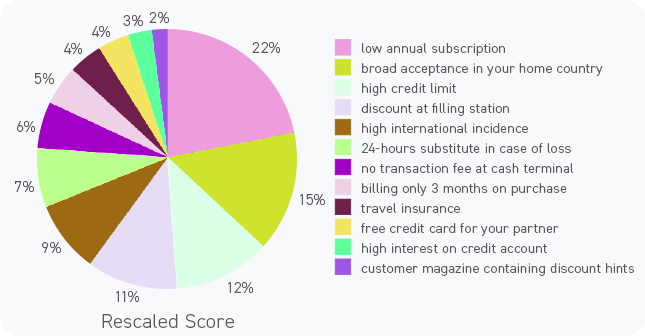Maximum Difference Scaling (MaxDiff)
Perfect interplay: The right Maxdiff design with the Maxdiff analysis suitable for your project
We at IfaD have all variants and extensions of MaxDiff scaling for your project in our portfolio. Our service uses our excellent CIS software to create the optimal MaxDiff design for desktop and smartphone on your behalf. Together with the appropriate MaxDiff analysis, we ensure that the MaxDiff evaluation of your preference measurement always delivers the best possible answers.
Make the right decision thanks to Maximum Difference Scaling (MaxDiff)
It is often necessary to use market research to identify the best or most important item from a series of features. This can be done with a MaxDiff analysis. For example, a credit card provider may wish to know which ancillary offers or services are most appreciated by the customer. Based on this, a MaxDiff design is created that provides alternative sets for the survey. MaxDiff scaling provides thus the possibility of calculating a complete ranking of all features by means of a simple questioning technique.
Procedure of the Survey Using the Maxdiff Method
In the MaxDiff method, the respondent is shown a few screens (or questionnaire pages) that are created with the MaxDiff design for the specific MaxDiff analysis. The MaxDiff design decides the number of choices. In the survey, the participant must state which of the credit services he prefers the most and which he prefers the least. In the subsequent MaxDiff evaluation, a value is determined for each service that reflects its importance compared to the others.
Advantages
- Variants of different fields (e.g. prices, brands, image aspects, concrete product characteristics) can be directly compared with one another. For example, conclusions can be drawn quickly from the MaxDiff analysis.
- Many variants can be included in the MaxDiff design. Up to 45 such features and levels are practicable within a survey. From the technical point of view, even as many as several hundred could be investigated at the same time.
- Completion of the survey tasks is very easy for the respondent, requiring little intellectual effort.

Results of a MaxDiff scaling on the subject of credit cards
- Due to the type of questioning (no ratings or rankings, but only best/most vs. worst/least) the results are very robust. There are no cultural influences, such as is usually the case with numerical ratings
- Interpretation of the MaxDiff evaluation is clear and easy. All the resulting values are between 0 and 100 in the MaxDff analysis. The values sum to 100, so that the individual values can also be interpreted as percentages. The results can therefore be implemented with confidence even with no previous experience of this form of analysis and without extensive training.
- The MaxDiff analysis delivers individual item values for each respondent. The results can thus be used for the investigation of specific sub-segments of the target group.
- The MaxDiff analysis questions can be implemented with practically all survey media (paper-and-pencil, CAPI, online, and for simple models even CATI).
The Limits of the MaxDiff Method and the Conjoint Alternative
- Especially on account of the simplicity of the test structure and results presentation, the MaxDiff analysis holds the danger of producing non-valid results. The results are delivered at the highest level of measurement, i.e. a ratio scale measurement. In order for these values to yield meaningful interpretation, the content of the stimulus material must fulfill correspondingly demanding requirements.
- For many types of survey, the MaxDiff method cannot replace conjoint analysis. Where it is necessary to compare products as whole with one another, and to provide a basis for e.g. simulation calculations, a conjoint methodology must be used.
- There are aspects that cannot be meaningfully compared using the MaxDiff method. For example it makes little sense to ask respondents to compare price levels. Normally the lowest price will always be selected, so that the amount of useful information obtained is practically zero. It is possible to avoid this by imposing restrictions on the survey conditions, but only at the cost of reducing the statistical reliability of the results.
Variants of MaxDiff Analysis – From our Portfolio
- MaxDiffs (Maximum Difference Scaling) on smartphone:
The space per screen is limited and the number of items to be displayed per screen is generally three to four, and the text of the items should not be too long and / or images should not be too small.
- Pictures / Texts / Tooltips:
As part of a MaxDiff you can use pictures and / or texts. Tooltips for some or all items are also possible.
- Adaptive MaxDiff:
As in a knockout round of a tournament, the best prevail, the weakest are eliminated. There is a focus on the preferred / important items. It should be noted that the number of tasks / questions is generally not reduced.
- Anchoring MaxDiff:
IfaD offers the direct method of the Anchoring MaxDiff. After the last MaxDiff task, another question is asked about the importance of the individual items. The goal is to anchor individual values in relation to a threshold. This threshold can be the acceptance threshold (zero point).
- Sparse MaxDiff:
A respondent sees each item less than three times (but at least once). Sparse MaxDiff is often used for 20 to 30 items.
- Express MaxDiff:
With the Express MaxDiff, only a part of the items (fixed number) are presented to each respondent. The selection is made individually or randomly. An Express MaxDiff can be used for a large number of items (> 30).
- Individualized MaxDiff:
The Individualized MaxDiff enables individual deselection / selection of items if we have a large number (> 30) of items.



